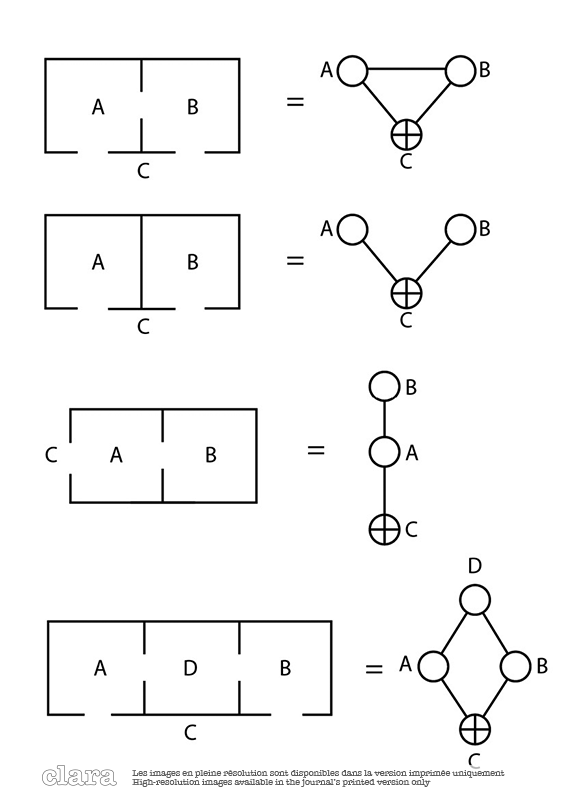In the Incas' footsteps. Pre-Columbian Architecture and Space Syntax
Main Article Content
Abstract
Pre-Columbian America's monumental architecture presents an interesting challenge in terms of the use of and circulation in built spaces, as it is not documented by texts or data other than archaeology and the vestiges themselves. In this study, the challenge is taken up by using the concepts and methods of internal circulation systems analysis developed for contemporary architecture by Hillier and Hanson (The Social Logic of Space, 1984). In particular, access analysis is applied to the Inca palace of Puruchuco in Lima.
The results are complemented by data from excavations and vernacular iconography, and then compared with the analysis of the palaces and elite residences of the region before its incorporation into the Inca Empire. This shows that the Incas used local genotypes in the design of their own administrative and management structures, in order to better establish their authority through traditional habitus.
Article Details

This work is licensed under a Creative Commons Attribution-NonCommercial-NoDerivatives 4.0 International License.
References
BORJA, A. 1973. Puruchuco, Lima, Editorial Jurídica.
CONRAD, G. W. 1977. «Chiquitoy Viejo: An Inca Administrative Center in the Chicama Valley, Peru», Journal of Field Archaeology n° 4(1), p.1-18.
CURATOLA PETROCCHI, M. 2001. «Adivinación, oráculos y civilizacíon andina», dans K. Makowski (éd), Los Dioses del antiguo Perú. Tomo 2, Lima, Banco de Crédito del Perú, p.222-267.
D’ALTROY, T. N. 2002. The Incas, Oxford, Blackwell Publishers.
EECKHOUT, P. 2004. «Pachacamac y el proyecto Ychsma (1999-2003)», dans P. Eeckhout (éd.), Arqueología de la Costa Central del Perú en los Periodos Tardíos, Volumen especial del Boletín del Instituto Francés de Estudios Andinos n° 33(3), p. 425-448.
EECKHOUT, P. 2005. «Imperial Strategies in a Regional Context: Chimus and Incas at Pachacamac», dans P. Eeckhout; G. Le Fort (éd.), Wars and Conflicts in Prehispanic Mesoamerica and the Andes, British Archaeological Reports International Series, 1385, Oxford, Hadrian Books Ltd, p. 110-127.
EECKHOUT, P. 2006. «Pachacamac, côte centrale du Pérou», dans L’archéologie à l’ULB (2001-2005), Centre de Recherches archéologiques de l’Université libre de Bruxelles, p. 123-132.
GASPARINI, G.; LUISE M., 1980. Inca Architecture, Bloomington, Indiana University Press.
HANSON, J. 1998. Decoding Home and Houses, New York, Cambridge University Press.
HILLIER, B.; HANSON, J. 1984. The social logic of space, New York, Cambridge University Press.
HYSLOP, J. 1990. Inka Settlement Planning, Austin, University of Texas Press.
JIMÉNEZ BORJA, A. 1973. Puruchuco, Lima, Editorial Jurídica.
MACKEY, C. J. 2006. «Elite Residences at Farfan: A Comparison of the Chimu and Inka Occupations», dans J.J. Christie; P. J. Sarro (éd), Palaces and Power in the Americas. From Peru to Northwest Coast, Austin, University of Texas Press, p. 313-352.
SANCHO DE LA HOZ, P. 1917(1534). «Relación para S.M. de lo sucedido en la conquista...», dans H.H. Urteaga (éd.), Colección de Libros y Documentos Referentes a la Historia del Perú, vol. 5, Lima, Sanmarti ediciones, p. 122-202.
UCEDA, S. 1997. «Esculturas en miniatura y una maqueta en madera», dans S. Uceda; E. Mujica; R. Morales (éd.), Investigaciones en la Huaca de la Luna 1995, Facultad de Ciencias SOCILES, Universidad Nacional de La Libertad-Trujillo, p. 151-176.
URTON, G.; BREZINE, C. G. 2007. «Information Control in the Palace of Puruchuco: An Accounting Hierarchy. A Khipu Archive from Coastal Peru», dans R. L. Burger; C. Morris; R. Matos Mendieta (éd.), Variations in the Expressions of Inka Power, Washington D.C., Dumbarton Oaks Research and Library Collection, p. 347-386.
VILLACORTA, L. F. 2004a. «Puruchuco, medio siglo después», dans L. F. Villacorta (éd.), Puruchuco y la sociedad de Lima: Un homenaje a Arturo Jiménez Borja, Lima, Concytec, p. 69-97.
VILLACORTA, L. F. 2004b. «Los palacios en la costa central durante los periodos tardíos: de Pachacamac al Inca», dans P. Eeckhout (éd.), Arqueología de la Costa Central del Perú en los Periodos Tardíos, Volumen especial del Boletín del Instituto Francés de Estudios Andinos, n° 33(3), p. 539-570.
WAKEHAM DASSO, R. 1976. Puruchuco, investigación arquitectónica, Departamento de Arquitectura y Urbanismo, Lima, Universidad Nacional de Ingeniería.

